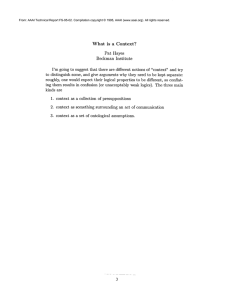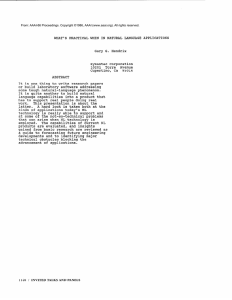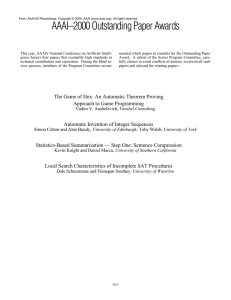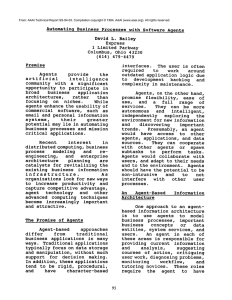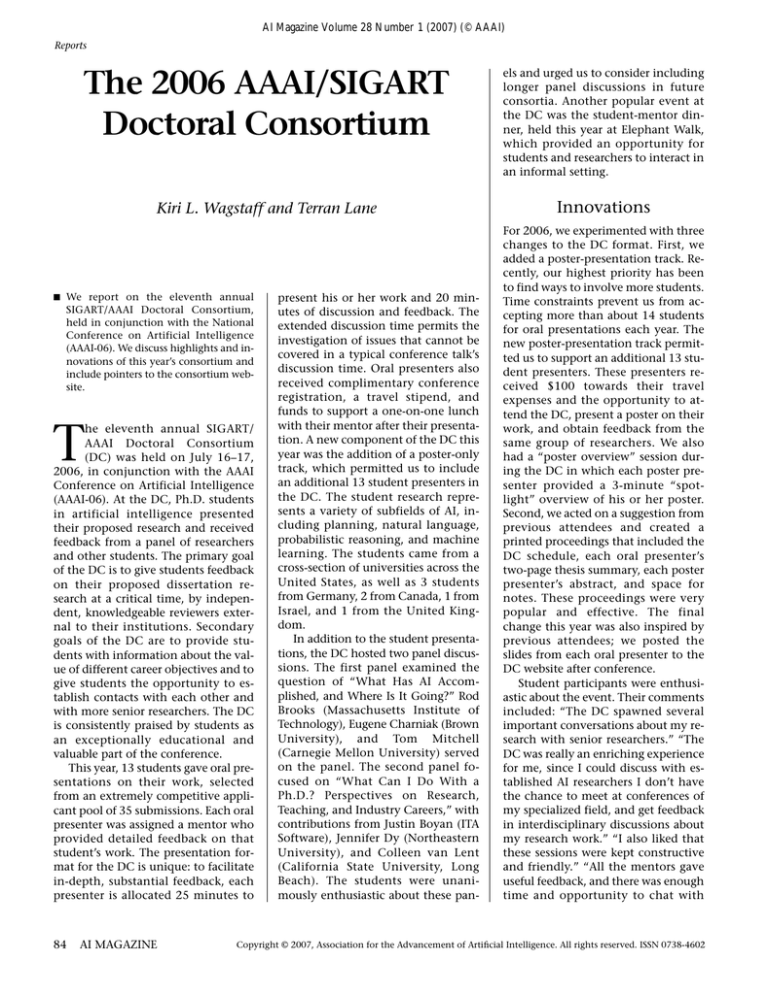
AI Magazine Volume 28 Number 1 (2007) (© AAAI)
Reports
The 2006 AAAI/SIGART
Doctoral Consortium
els and urged us to consider including
longer panel discussions in future
consortia. Another popular event at
the DC was the student-mentor dinner, held this year at Elephant Walk,
which provided an opportunity for
students and researchers to interact in
an informal setting.
Kiri L. Wagstaff and Terran Lane
Innovations
■ We report on the eleventh annual
SIGART/AAAI Doctoral Consortium,
held in conjunction with the National
Conference on Artificial Intelligence
(AAAI-06). We discuss highlights and innovations of this year’s consortium and
include pointers to the consortium website.
T
he eleventh annual SIGART/
AAAI Doctoral Consortium
(DC) was held on July 16–17,
2006, in conjunction with the AAAI
Conference on Artificial Intelligence
(AAAI-06). At the DC, Ph.D. students
in artificial intelligence presented
their proposed research and received
feedback from a panel of researchers
and other students. The primary goal
of the DC is to give students feedback
on their proposed dissertation research at a critical time, by independent, knowledgeable reviewers external to their institutions. Secondary
goals of the DC are to provide students with information about the value of different career objectives and to
give students the opportunity to establish contacts with each other and
with more senior researchers. The DC
is consistently praised by students as
an exceptionally educational and
valuable part of the conference.
This year, 13 students gave oral presentations on their work, selected
from an extremely competitive applicant pool of 35 submissions. Each oral
presenter was assigned a mentor who
provided detailed feedback on that
student’s work. The presentation format for the DC is unique: to facilitate
in-depth, substantial feedback, each
presenter is allocated 25 minutes to
84
AI MAGAZINE
present his or her work and 20 minutes of discussion and feedback. The
extended discussion time permits the
investigation of issues that cannot be
covered in a typical conference talk’s
discussion time. Oral presenters also
received complimentary conference
registration, a travel stipend, and
funds to support a one-on-one lunch
with their mentor after their presentation. A new component of the DC this
year was the addition of a poster-only
track, which permitted us to include
an additional 13 student presenters in
the DC. The student research represents a variety of subfields of AI, including planning, natural language,
probabilistic reasoning, and machine
learning. The students came from a
cross-section of universities across the
United States, as well as 3 students
from Germany, 2 from Canada, 1 from
Israel, and 1 from the United Kingdom.
In addition to the student presentations, the DC hosted two panel discussions. The first panel examined the
question of “What Has AI Accomplished, and Where Is It Going?” Rod
Brooks (Massachusetts Institute of
Technology), Eugene Charniak (Brown
University), and Tom Mitchell
(Carnegie Mellon University) served
on the panel. The second panel focused on “What Can I Do With a
Ph.D.? Perspectives on Research,
Teaching, and Industry Careers,” with
contributions from Justin Boyan (ITA
Software), Jennifer Dy (Northeastern
University), and Colleen van Lent
(California State University, Long
Beach). The students were unanimously enthusiastic about these pan-
For 2006, we experimented with three
changes to the DC format. First, we
added a poster-presentation track. Recently, our highest priority has been
to find ways to involve more students.
Time constraints prevent us from accepting more than about 14 students
for oral presentations each year. The
new poster-presentation track permitted us to support an additional 13 student presenters. These presenters received $100 towards their travel
expenses and the opportunity to attend the DC, present a poster on their
work, and obtain feedback from the
same group of researchers. We also
had a “poster overview” session during the DC in which each poster presenter provided a 3-minute “spotlight” overview of his or her poster.
Second, we acted on a suggestion from
previous attendees and created a
printed proceedings that included the
DC schedule, each oral presenter’s
two-page thesis summary, each poster
presenter’s abstract, and space for
notes. These proceedings were very
popular and effective. The final
change this year was also inspired by
previous attendees; we posted the
slides from each oral presenter to the
DC website after conference.
Student participants were enthusiastic about the event. Their comments
included: “The DC spawned several
important conversations about my research with senior researchers.” “The
DC was really an enriching experience
for me, since I could discuss with established AI researchers I don’t have
the chance to meet at conferences of
my specialized field, and get feedback
in interdisciplinary discussions about
my research work.” “I also liked that
these sessions were kept constructive
and friendly.” “All the mentors gave
useful feedback, and there was enough
time and opportunity to chat with
Copyright © 2007, Association for the Advancement of Artificial Intelligence. All rights reserved. ISSN 0738-4602
Reports
other researchers and mentors as
well.” “I really liked the concept of a
mentor for every student, and my
mentor especially gave me feedback
on multiple issues in a very short period of time.” “I had a great time listening to people working on interesting
problems in fields extremely different
to mine, but surprisingly I was still
able to find similarities between their
problems and those that I am trying to
tackle.” “The most satisfying thing in
my case was to be able to meet a few
other students who were really excited
about their research.”
For more information, including
links to student abstracts and presentations, visit the 2006 DC website at
litech.org/~wkiri/dc06. This event was
organized and run by Kiri Wagstaff (Jet
Propulsion Laboratory) and Terran
Lane (University of New Mexico). To
learn about the upcoming 2007 DC,
visit AAAI’s website. All conference
participants are welcome to attend as
audience members, and students are
particularly encouraged to do so. Many
student presenters were inspired by
their attendance at a previous DC, and
several reported that just watching
others present their dissertation research and plans gave them a plethora
of ideas for their own work.
7th International Conference on
Intelligent Virtual Agents (IVA’07)
17th – 19th September 2007, Paris, France
http://iva07.ntua.gr
Plus GALA – Gathering of Life-like Agents
07
Submission deadline: April 15th 2007
Held in cooperation with the
Association for the Advancement
of Artificial Intelligence (AAAI)
The conference invites submissions from these topics:
Social Intelligent Agents
Multimodal behavior modeling
Conceptual Architectures for Agents
Applications for Intelligent Virtual Agents
Cognitive Modeling / Real-time Agent Systems
Evaluation and Methodology / Embodied Agents
Organizing Committee:
Catherine Pelachaud, Jean-Claude Martin
Elisabeth André, Kostas Karpouzis, Danielle Pelé
Ruth Aylett, Jonathan Gratch, Patrick Olivier, Stefan Kopp
Sponsored by:
Univ. Paris 8, CNRS-LIMSI, France Telecom
ENST, Univ. Augsburg, ICCS
Acknowledgements
We gratefully acknowledge financial
support from the National Science
Foundation (thanks to Edwina Rissland and Bill Bainbridge), Microsoft
Research (thanks to Eric Horvitz), and
Google (thanks to David Cohn). We
would also like to thank Carol Hamilton, Keri Harvey, and Colleen Boyce at
AAAI for managing submissions, notifications, and awards and for handling
the local arrangements. Thanks to
them, the event went off smoothly,
and the students were very appreciative. Our thanks are also extended to
the 19 reviewers and mentors and six
panelists for generously donating their
time and effort.
Kiri L. Wagstaff is a senior researcher at the
Jet Propulsion Laboratory in Pasadena, CA.
She is a member of the Machine Learning
and Instrument Autonomy group, and her
focus is on developing new machine-learn-
ing methods that can be
used for data analysis
on-board spacecraft.
She has applied these
techniques to data being collected by the EO1 Earth-orbiting spacecraft, Mars Odyssey, and
Mars Pathfinder. She
has also worked on crop-yield prediction
from orbital remote-sensing observations,
the fault-protection system for the MESSENGER mission to Mercury, and automatic code generation for the Electra radios
used by the Mars Reconnaissance Orbiter
and the Mars Science Laboratory. She holds
a Ph.D. in computer science from Cornell
University and is currently working on an
M.S. in geology from the University of
Southern California.
Terran Lane is an assistant professor of
computer science at the University of New
Mexico. His research focus is on developing novel machine learning methods
grounded in difficult real-world scientific
data analysis problems. His interests fall
into a subspace that is roughly spanned by
time-series analysis, Bayesian networks,
handling high-dimensional and nonlinear
data, semisupervised and unsupervised
learning, learning network structure from
data, and decision-theoretic control and
reinforcement learning. He has developed
and applied techniques from this space to
problems including computer security, user modeling, bioinformatics (RNA interference and genomics), and neuroinformatics (analysis of functional magnetic
resonance imaging [fMRI] data and diagnosis of mental disease). He received his
Ph.D. from Purdue University in 2000,
spent two years as a postdoctoral researcher at the Massachusetts Institute of
Technology, and then took up residence in
the sunny Southwest.
SPRING 2007
85

